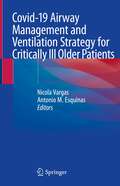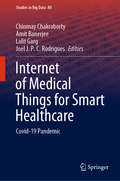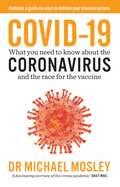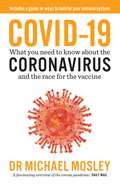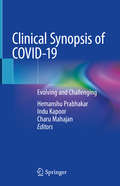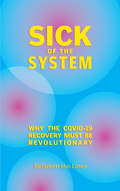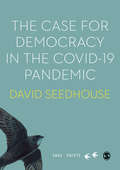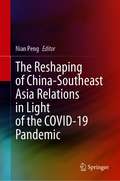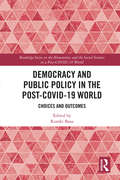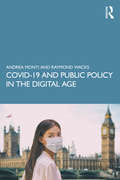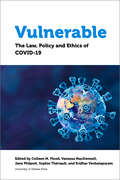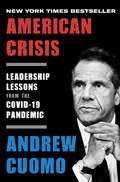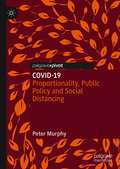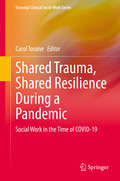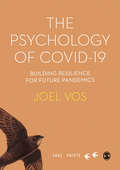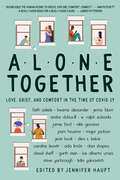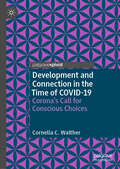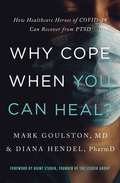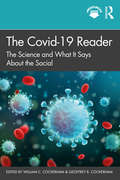Special Collections
Everything you ever wanted to know about the COVID-19 pandemic
- Table View
- List View
Covid-19 Airway Management and Ventilation Strategy for Critically Ill Older Patients
by Antonio M. Esquinas and Nicola VargasThis book describes the issues and challenges that clinicians encountered in the management of older critically ill patients during the Covid-19 pandemic, and offers practical information on how to manage them. Older adults are more susceptible to complications such as acute respiratory distress syndrome (ARDS) as a result of viral pneumonia. In addition, they often have multiple comorbidities and are commonly frail, which means their various organs and systems, such as the respiratory system, have reduced functional reserves. As such, older adults are less able to react to acute stressors. During the current Covid-19 pandemic, older adult patients' mortality is increased. Further, the infection and death rates of elderly people in nursing homes and health care institutions are high.Management of older adults with Covid is complicated. The reduced availability of beds may limit their access to ICU. Moreover, the prognosis may be poor, and airway management and ventilation strategies have to take into account various clinical and physiological characteristics specific to older patients. This book is addressed to all allied professionals involved in the management of older critically ill patients and presents information collected and practical lessons learned from the clinical daily management of this population during the pandemic.
Internet of Medical Things for Smart Healthcare
by Amit Banerjee and Joel J. P. C. Rodrigues and Chinmay Chakraborty and Lalit GargThis book covers COVID-19 related research works and focuses on recent advances in the Internet of Things (IoT) in smart healthcare technologies. It includes reviews and original works on COVID-19 in terms of e-healthcare, medicine technology, life support systems, fast detection, diagnoses, developed technologies and innovative solutions, bioinformatics, datasets, apps for diagnosis, solutions for monitoring and control of the spread of COVID-19, among other topics. The book covers comprehensive studies from bioelectronics and biomedical engineering, artificial intelligence, and big data with a prime focus on COVID-19 pandemic.
COVID-19
by Dr Michael MosleyAustralia and New Zealand edition From award-winning science journalist Dr Michael Mosley: The story of COVID-19, the greatest public health threat of our time ... This book charts the trajectory of a novel virus, from its emergence in China at the end of 2019 to its rapid worldwide spread. Based on the latest scientific discoveries, Dr Mosley provides a fascinating and detailed understanding of the secrets of this coronavirus, how it spreads, how it infects your body and how your immune system tries to fight back. With access to leading experts, he reports on the battle to find treatments and a safe and effective vaccine (ultimately, the only way to defeat the virus). Armed with the facts about COVID-19 you’ll be in a better position to protect yourself and your family as the world begins to reopen. Eating well, sleeping soundly, exercising and managing stress are all vital for keeping your body and immune system in the best possible shape to fight the virus. These are areas where Dr Mosley, creator of the 5:2 diet, is well known for his science-based and practical approach. ‘This is an incredibly readable summary of the latest research. A magical mixture of scientific realism and reasoned hope.’ Dr Mathew Vadas, Professor of Medicine and leading immunologist, Centenary Institute and University of Sydney
COVID-19
by Dr Michael MosleyDiscover the most essential and comprehensive information about the coronavirus (COVID-19) pandemic, how to ward off infection, and safeguard your mental and physical health during isolation—from the award-winning science journalist and #1 New York Times bestselling author of The Fast 800 and The FastDiet. Dr. Michael Mosley has experienced the effects of coronavirus firsthand, as he and both his sons—medical professionals in their twenties—all became ill during the height of the pandemic in London. Now recovered, Dr. Mosley shares his insights and explains the science behind the greatest public health crisis of our time. From the emergence of the novel virus in China at the end of 2019 to its rapid worldwide spread, this clear, detailed guide provides you with a basic understanding of the virus, how it jumps from person to person, how it can be overcome, and the most effective ways to protect yourself and your family. Featuring in-depth interviews with leading doctors and virus researchers working on the front lines to defeat this microscopic enemy, COVID-19 also tracks the ongoing developments in finding new treatments and an effective vaccine—the only way to ultimately halt the spread of the virus. Offering highly readable, easy-to-digest information about this global pandemic, Dr. Mosley&’s COVID-19 is the ultimate resource to help you feel better informed and take care of yourself as we all work through this global crisis.
Framework for Equitable Allocation of COVID-19 Vaccine
by Board on Population Health and Public Health Practice and Board on Health Sciences Policy and National Academies of Sciences, Engineering, and Medicine and Health and Medicine Division and Committee on Equitable Allocation of Vaccine for the Novel CoronavirusIn response to the coronavirus disease 2019 (COVID-19) pandemic and the societal disruption it has brought, national governments and the international community have invested billions of dollars and immense amounts of human resources to develop a safe and effective vaccine in an unprecedented time frame. Vaccination against this novel coronavirus, severe acute respiratory syndrome coronavirus 2 (SARS-CoV-2), offers the possibility of significantly reducing severe morbidity and mortality and transmission when deployed alongside other public health strategies and improved therapies. Health equity is intertwined with the impact of COVID-19 and there are certain populations that are at increased risk of severe illness or death from COVID-19. In the United States and worldwide, the pandemic is having a disproportionate impact on people who are already disadvantaged by virtue of their race and ethnicity, age, health status, residence, occupation, socioeconomic condition, or other contributing factors. Framework for Equitable Allocation of COVID-19 Vaccine offers an overarching framework for vaccine allocation to assist policy makers in the domestic and global health communities. Built on widely accepted foundational principles and recognizing the distinctive characteristics of COVID-19, this report's recommendations address the commitments needed to implement equitable allocation policies for COVID-19 vaccine.
Clinical Synopsis of COVID-19
by Hemanshu Prabhakar and Charu Mahajan and Indu KapoorCorona virus disease or COVID-19 or SARS-CoV-2 infection is the latest pandemic that has affected humans globally. The disease has manifested itself in several forms and is now the focus of research worldwide. This book covers all the clinical aspects of the novel corona virus disease, COVID-19, which is one of the most contagious diseases ever known. It includes topics related to basic sciences, such as the virology and pathophysiology of the SARS-CoV-2 disease. It includes chapters related to symptomatology of the disease and making diagnosis, preparation of the health care workers to deal with this global pandemic. The book includes chapters on anesthetic and intensive care management of COVID-19 disease victims as these topics are of vast importance. Additionally, it includes a chapter giving insight in to the ethical aspects of the issues raised regarding disposal of bodies of the victims, as this pandemic has taken many lives across the world. It includes a chapter on special considerations to patient population such as geriatrics, pediatrics and pregnant women. The book serves as a useful resource for practitioners and clinicians in any field of medicine. It is also relevant for residents, trainees, fellows pursuing their courses in emergency medicine, anesthesia and critical care as well as postgraduates and even undergraduates. The book will serve as a ready-reckoner and useful guide for physicians from varied specialties during their clinical practice.
COVID-19 Testing at Everlywell
by Jeffrey J. Bussgang and Olivia HullIn March 2020, as COVID-19 spreads rapidly across the U.S., Everlywell founder Julia Cheek considers how to respond as a small start-up specializing in at-home lab testing. After making dramatic budget cuts, she decides to pivot the organization to address the country's testing shortage. But after a hectic few weeks building capacity at her partner labs to 30,000 COVID daily tests, the U.S. Food and Drug Administration (FDA) releases a statement warning the public that it has not granted approval for at-home tests. Cheek must decide whether to return to her core business or persist in focusing her nascent organization on COVID-19 tests, an opportunity whose commercial merit is unclear.
Merck: Covid-19 Vaccines
by Willy ShihCovid-19 infections were still climbing across the U.S. and many other parts of the world in September 2020, and it seemed that every time Ken Frazier, the CEO of Merck & Co. consented to an interview in recent months he always seemed to hear the same question, "Where's Merck?" The company, a leader in the global vaccine business had a low public profile even though it was working assiduously on two vaccine candidates for the SARS-CoV-2 virus that causes Covid-19. The U.S. Government had initiated a high profile program - Operation Warp Speed (OWS) - to accelerate the development of vaccines, but Merck was notably absent. Should Merck seek or accept funding from OWS, and what terms might accompany such an agreement?
Sick of the System
by John Clarke and Richard Swift and Emma Jackson and Justin Piché and Alberto Toscano and Jamie Swift and Harry Glasbeek and Gary Kinsman and Kai Cheng Thom and Robyn Maynard and Andrew Jackson and Anita Girvan and James T. Brophy and Nicole Marie Burton and Dallas Hunt and El Jones and Margaret M. Keith and Julie S. Lalonde and Wayne Lewchuk and Jane E. McArthur and Alexander McClelland and Karen Messing and Elaine Power and Gina Starblanket and Hugh D.A. GoldringFamilies left grieving; small businesses shuttered; communities in lockdown; precarious workers set adrift; health care workers stressed beyond endurance. The COVID-19 pandemic has shaken the world to its core. But the cracks already ran deep. Featuring essays on poverty, health care, incarceration, basic income, policing, Indigenous communities, and more, this anthology delivers a stinging rebuke of the pre-pandemic status quo and a stark exposé of the buried weaknesses in our social and political systems. As policy makers scramble to bail out corporations and preserve an unsustainable labour market, an even greater global catastrophe – in the form of ecological collapse, economic recession, and runaway inequality – looms large on the horizon. What can we do? From professors to poets, the authors of Sick of the System speak in one voice: We can turn our backs on “normal.” We can demand divestment, redistribution, and mutual aid. We can seize new forms of solidarity with both hands. As the world holds its breath, revolutionary ideas have an unprecedented chance to gain ground. There should be no going back.
The Case for Democracy in the COVID-19 Pandemic
by David SeedhouseOne moment life was normal, the next, governments around the world were imposing radical lockdowns of their populations. But why were decision-makers so readily ignoring centuries of hard-won civil freedoms? Where was the discussion of ethics and human rights? Why were we so easily controlled and why were our controllers so willing to do it? In The Case for Democracy, David Seedhouse explores the psychological biases; distorted risk perceptions; frenetic journalism; the disputed science; the narrow focus of ′experts′; value judgements dressed up as truths; propaganda; the invisibility of ethics; and the alarming irrelevance of inclusive democracy that have been features of governmental responses to the covid-19 pandemic. Seedhouse argues that the chaotic governmental response to Coronavirus, with no attempt to include the public, is the perfect argument for an extensive, participatory democracy; a democracy that demonstrates practical decision making by listening to everyone’s knowledge and expertise. Now is the time for us to solve our problems together.
The Case for Democracy in the COVID-19 Pandemic
by David SeedhouseOne moment life was normal, the next, governments around the world were imposing radical lockdowns of their populations. But why were decision-makers so readily ignoring centuries of hard-won civil freedoms? Where was the discussion of ethics and human rights? Why were we so easily controlled and why were our controllers so willing to do it? In The Case for Democracy, David Seedhouse explores the psychological biases; distorted risk perceptions; frenetic journalism; the disputed science; the narrow focus of ′experts′; value judgements dressed up as truths; propaganda; the invisibility of ethics; and the alarming irrelevance of inclusive democracy that have been features of governmental responses to the covid-19 pandemic. Seedhouse argues that the chaotic governmental response to Coronavirus, with no attempt to include the public, is the perfect argument for an extensive, participatory democracy; a democracy that demonstrates practical decision making by listening to everyone’s knowledge and expertise. Now is the time for us to solve our problems together.
The Reshaping of China-Southeast Asia Relations in Light of the COVID-19 Pandemic
by Nian PengThis book aims to examine the multiple effects of the COVID-19 pandemic on China-Southeast Asia relations from both Chinese and Southeast Asian perspectives. It invites many officials and scholars from the leading think-tanks and famous universities in China and Southeast Asian states to contribute and tries to reveal how has China-Southeast Asia relations been reshaping during/after the COVID-19 pandemic and discuss what kind of measures could be taken to push forward China-Southeast Asia relations and thus ensuring the peace and prosperity in the region. The main content of this book is divided into 10 parts, in which the first chapter briefly introduces the COVID-19 situation in China and Southeast Asia, China’s anti-COVID efforts, and the impacts of the COVID-19 on China-Southeast Asia relations from Chinese and Southeast Asian perspectives. Chapter 2 examines the dual influence of the pandemic on the construction of China-ASEAN community of a shared future and gave some useful policy recommendations on improving China-Southeast Asia relations. The following 8 chapters go deep into the Southeast Asian states’ response to COVID-19 and the economic, political and social effects of the COVID-19 on Southeast Asia–China relations, and look forward the future development of such relations. In addition, it also analyzes Southeast states’ reactions to the intense Sino-US power rivalry during/after the COVID-19 pandemic.This book is probably the first comprehensive study that investigates the impacts of the COVID-19 pandemic on China–Southeast Asia relations from both Chinese and Southeast Asian perspectives. It would not only open up a new area of study on China and Southeast Asia relations, but provide insightful observations and useful information for governments, companies and social organizations to facilitate cooperation in trade and investment, public health, and people-to-people exchanges. Therefore, the intended readership not only includes the academics but also officials, businessmen, journalists and social activists.The most important feature of this book is that it points out China–Southeast Asia relations would be reshaped by COVID-19 in the long run and analyzes how it would be reshaped. It also shows a well-balanced view on the COVID-19 and China–Southeast Asia relations as both university scholars, think-tank experts and government officials are involved in this book.
Democracy and Public Policy in the Post-COVID-19 World
by Rumki BasuAfter the COVID-19 disaster, ‘old’ frailties and inadequacies in agriculture and industrial productive capacities, in public health and transport systems have evinced sharply in the open, reopening the debates over public policy reforms as never before. This volume: Studies the likely impact of the COVID-19 pandemic on future policy making in India and other democracies. Critically looks at the available theoretical frameworks, models and approaches used in the policy making process and studies their contemporary relevance. Balances theoretical approaches with concrete case studies. Examines India’s policies on education, health, e-governance, gender and work, and also provides recommendations for the future. An important and timely contribution, this book will be of great interest to scholars and researches of public administration, public policy, political theory, globalization and global democracy.
COVID-19 and Public Policy in the Digital Age
by Raymond Wacks and Andrea MontiCOVID-19 and Public Policy in the Digital Age explores how states and societies have responded to the COVID-19 pandemic and their long-term implications for public policy and the rule of law globally. It examines the extent to which existing methods of protecting public safety and national security measure up in a time of crisis. The volume also examines how these ideas themselves have undergone transformation in the context of the global crisis. This book: Explores the intersection of public policy, individual rights, and technology; Analyzes the role of science in determining political choices; Reconsiders our understanding of security studies on a global scale arising out of antisocial behaviour, panic buying, and stockpiling of food and (in the United States) arms; Probes the role of fake news and social media in crisis situations; and Provides a critical analysis of the notion of global surveillance in relation to the pandemic. A timely, prescient volume on the many ramifications of the pandemic, this book will be essential reading for professionals, scholars, researchers, and students of public policy, especially practitioners working in the fields of technology and society, security studies, law, media studies, and public health.
Vulnerable
by Ravi Malhotra and Jeffrey Simpson and Paul Daly and David Robitaille and Jomo Kwame Sundaram and Katherine Fierlbeck and Grégoire Webber and Pat Armstrong and Hugh Armstrong and Jane Philpott and Delphine Nakache and Ivy Bourgeault and Daniel Weinstock and Aimée Craft and Anis Chowdhury and Teresa Scassa and Chidi Oguamanam and E. Richard Gold and Olivia Lee and Carissima Mathen and Steven J. Hoffman and Vanessa Gruben and Martha Jackman and Bryan Thomas and Lorian Hardcastle and Deborah McGregor and Jeffery Hewitt and Michelle Giroux and Amir Attaran and Adam R. Houston and Alexandra Flynn and Mel Cappe and Tim Caulfield and Marie-France Fortin and Jennifer A. Quaid and Dr Kumanan Wilson and Kelly Bronson and Jason Millar and Vardit Ravitsky and Terry Skolnik and Yves Le Bouthillier and Martine Lagacé and Linda Garcia and Leilani Farha and Kaitlin Schwan and Adelina Iftene and Jamie Chai Liew and Y. Y. Chen and Anne Levesque and Dr Kwame McKenzie and Jennifer A. Chandler and Dr Mona Gupta and Yasmin Khaliq and Simon Hatcher and Tess Sheldon and Katherine Lippel and Louise Bélanger-Hardy and Sarah Berger Richardson and Sam Halabi and Patrick Fafard and Céline Castets-Renard and Eleonore Fournier-Tombs and Jeremy De Beer and Matthew Herder and Jason W. NickersonThe novel coronavirus SARS-CoV-2, which causes the disease known as COVID-19, has infected people in 212 countries so far and on every continent except Antarctica. Vast changes to our home lives, social interactions, government functioning and relations between countries have swept the world in a few months and are difficult to hold in one’s mind at one time. That is why a collaborative effort such as this edited, multidisciplinary collection is needed. This book confronts the vulnerabilities and interconnectedness made visible by the pandemic and its consequences, along with the legal, ethical and policy responses. These include vulnerabilities for people who have been harmed or will be harmed by the virus directly and those harmed by measures taken to slow its relentless march; vulnerabilities exposed in our institutions, governance and legal structures; and vulnerabilities in other countries and at the global level where persistent injustices harm us all. Hopefully, COVID-19 will forces us to deeply reflect on how we govern and our policy priorities; to focus preparedness, precaution, and recovery to include all, not just some. Published in English with some chapters in French.
American Crisis
by Andrew CuomoGovernor Andrew Cuomo tells the riveting story of how he took charge in the fight against COVID-19 as New York became the epicenter of the pandemic, offering hard-won lessons in leadership and his vision for the path forward. When COVID-19 besieged the United States, New York State emerged as the global “ground zero” for a deadly contagion that threatened the lives and livelihoods of millions. Quickly, Governor Andrew Cuomo provided the leadership to address the threat, becoming the standard-bearer of the organized response the country desperately needed. With infection rates spiking and more people dying every day, the systems and functions necessary to combat the pandemic in New York—and America—did not exist.
So Cuomo undertook the impossible. He unified people to rise to the challenge and was relentless in his pursuit of scientific facts and data. He quelled fear while implementing an extraordinary plan for flattening the curve of infection. He and his team worked day and night to protect the people of New York, despite roadblocks presented by a president incapable of leadership and addicted to transactional politics. Taking readers beyond the candid daily briefings that became must-see TV across the globe, and providing a dramatic, day-by-day account of the catastrophe as it unfolded, American Crisis presents the intimate and inspiring thoughts of a leader at an unprecedented historical moment.
In his own voice, Andrew Cuomo chronicles the ingenuity and sacrifice required of so many to fight the pandemic, sharing the decision-making that shaped his policy as well as his frank accounting and assessment of his interactions with the federal government, the White House, and other state and local political and health officials. Real leadership, he shows, requires clear communication, compassion for others, and a commitment to truth-telling—no matter how frightening the facts may be. Including a game plan for what we as individuals—and as a nation—need to do to protect ourselves against this disaster and those to come, American Crisis is a remarkable portrait of selfless leadership and a gritty story of difficult choices that points the way to a safer future for all of us.
A New York Times Bestseller
COVID-19
by Peter MurphyCOVID-19: Proportionality, Public Policy and Social Distance explores the social and political response to the COVID-19 pandemic. It details the sociological aspects of the spread of the virus, the role played by social distancing in virus mitigation, and the comparative effect of social proximity and distance on national anti-viral behavior. Peter Murphy discusses various public policy approaches to the pandemic and their successes and failures. In this engaging analysis, he investigates the way that contemporary societies think about risk, threat and harm, and how social mood affected the response to COVID-19.
Decarcerating Correctional Facilities during COVID-19
by Division of Behavioral and Social Sciences and Education and Committee on Law and Justice and National Academies of Sciences, Engineering, and Medicine and Committee on the Best Practices for Implementing Decarceration as a Strategy to Mitigate the Spread of COVID-19 in Correctional FacilitiesThe conditions and characteristics of correctional facilities - overcrowded with rapid population turnover, often in old and poorly ventilated structures, a spatially concentrated pattern of releases and admissions in low-income communities of color, and a health care system that is siloed from community public health - accelerates transmission of the novel coronavirus (SARS-CoV-2) responsible for COVID-19. Such conditions increase the risk of coming into contact with the virus for incarcerated people, correctional staff, and their families and communities. Relative to the general public, moreover, incarcerated individuals have a higher prevalence of chronic health conditions such as asthma, hypertension, and cardiovascular disease, making them susceptible to complications should they become infected. Indeed, cumulative COVID-19 case rates among incarcerated people and correctional staff have grown steadily higher than case rates in the general population. Decarcerating Correctional Facilities during COVID-19 offers guidance on efforts to decarcerate, or reduce the incarcerated population, as a response to COIVD-19 pandemic. This report examines best practices for implementing decarceration as a response to the pandemic and the conditions that support safe and successful reentry of those decarcerated.
Shared Trauma, Shared Resilience During a Pandemic
by Carol TosoneThis contributed volume reflects on the collective wisdom and ongoing efforts of the social work profession that has been in the forefront of the global pandemic of COVID-19. The contributors are seasoned social work academics, practitioners, administrators, and researchers. Working on the frontlines with patients and families, these social workers have garnered experiences and insights, and also have developed innovative ways to mitigate the impact of the coronavirus on the psychosocial well-being of their clients and themselves. The 36 reflections, experiences, and insights in this curated collection address the behavioral, mental health, socioeconomic, and other repercussions of the coronavirus pandemic that have impacted their client base, most of whom are vulnerable populations:Repurposed, Reassigned, Redeployed Safety Planning with Survivors of Domestic Violence: How COVID-19 Shifts the FocusCOVID-19 and Moral Distress/Moral Anguish Therapeutic Support for Healthcare Workers in Acute Care: Our VoiceShared Trauma and Harm Reduction in the Time of COVID-19Wholeheartedness in the Treatment of Shared Trauma: Special Considerations During the COVID-19 PandemicThe Role of Ecosocial Work During the COVID-19 Pandemic: The Natural WorldBlack Lives, Mass Incarceration, and the Perpetuity of Trauma in the Era of COVID-19: The Road to Abolition Social WorkTeaching Social Work Practice in the Shared Trauma of a Global Pandemic The COVID-19 Self-Care Survival Guide: A Framework for Clinicians to Categorize and Utilize Self-Care Strategies and PracticesShared Trauma, Shared Resilience During a Pandemic: Social Work in the Time of COVID-19 is an early and essential work on the impact of the pandemic on the social work field with useful practice wisdom for a broad audience. It can be assigned in masters-level social work practice and elective courses on trauma, as well as inform both neophyte and experienced practitioners. It also would appeal to the general public interested in the work of social workers during a pandemic.
The Psychology of Covid-19: Building Resilience for Future Pandemics
by Joel VosThe Psychology of Covid-19 explores how the coronavirus is giving rise to a new order in our personal lives, societies and politics. Rooted in systematic research on Covid-19 and previous pandemics, including SARS, Ebola, HIV and the Spanish Flu, this book describes how Covid-19 has impacted a broad range of domains, including self-perception, lifestyle, politics, mental health, media, and meaning in life. Building on this, the book then sets out how we can improve our psychological and social resilience, to safeguard ourselves against the psychological effects of future pandemics.
The Psychology of Covid-19: Building Resilience for Future Pandemics
by Joel VosThe Psychology of Covid-19 explores how the coronavirus is giving rise to a new order in our personal lives, societies and politics. Rooted in systematic research on Covid-19 and previous pandemics, including SARS, Ebola, HIV and the Spanish Flu, this book describes how Covid-19 has impacted a broad range of domains, including self-perception, lifestyle, politics, mental health, media, and meaning in life. Building on this, the book then sets out how we can improve our psychological and social resilience, to safeguard ourselves against the psychological effects of future pandemics.
Alone Together
by Jenna Blum and Garth Stein and Kwame Alexander"Could there be a timelier gift to quarantined readers...? I doubt it."—The Washington Post"A heartening gathering of writers joining forces for community support."—Kirkus Reviews"Connects writers, readers, and booksellers in a wonderfully imaginative way. It's a really good book for a really good cause"—Bestselling author James PattersonALONE TOGETHER: Love, Grief, and Comfort in the Time of COVID-19 is a collection of essays, poems, and interviews to serve as a lifeline for negotiating how to connect and thrive during this stressful time of isolation as well as a historical perspective that will remain relevant for years to come.All contributing authors and business partners are donating their share to The Book Industry Charitable Foundation (Binc), a nonprofit organization that coordinates charitable programs to strengthen the bookselling community.The roster of diverse voices includes Faith Adiele, Kwame Alexander, Jenna Blum, Andre Dubus III, Jamie Ford, Nikki Giovanni, Pam Houston, Jean Kwok, Major Jackson, Devi S. Laskar, Caroline Leavitt, Ada Limón, Dani Shapiro, David Sheff, Garth Stein, Luis Alberto Urrea, Steve Yarbrough, and Lidia Yuknavitch.The overarching theme is how this age of isolation and uncertainty is changing us as individuals and a society."Alone Together showcases the human desire to grieve, explore, comfort, connect, and simply sit with the world as it weathers the pandemic. Jennifer Haupt's timely and moving anthology also benefits the Book Industry Charitable Foundation, making it a project that is noble in both word and deed."—Ann Patchett, Bestselling author, bookseller, and Co-Ambassador for The Book Industry Charitable Foundation
Development and Connection in the Time of COVID-19
by Cornelia C. WaltherThis book looks at the COVID-19 pandemic and its likely aftermath through a four-dimensional prism - aspirations, emotions, thoughts, and sensations to understand human behavior. That perspective opens possibilities to turn the current crisis into an opportunity for positive change; because systematically influencing the various components of our being, individually and collectively, begins by understanding their nature and interaction. Beyond influence this interplay between dimensions can be optimized; which is the purpose of the C-Core (completion, compassion, creativity, cooperation) introduced in the book. In addition, the four determinants that shape institutions: priorities, people, positions, programs - the P-Puzzle are looked at. This book combines theory and concrete suggestions both for policymakers in charge of designing the collective landscape and for individuals who must adapt to, and shape, a new ‘normal’. COVID-19 is a reminder that humans around the World are fundamentally the same. Whether in the long run the Pandemic will bring out the best or the worst in humans depends on individual and collective choices to nurture our best individual and collective selves. COVID-19 may either expand life quality by adding a new breadth of solidarity or reduce Society to mere survival.
Why Cope When You Can Heal?
by Mark Goulston and Diana HendelWhy Cope When You Can Heal? is an essential resource for doctors, nurses, paramedics, and other healthcare professionals—and the leaders who support them—as they navigate the traumatic stress they have experienced and continue to face.COVID-19 has traumatized the world—and no group has been more impacted than frontline healthcare workers. They&’ve worked without adequate personal protective equipment (PPE), witnessed mass death, and been forced to make choices that haunt them. Many have fallen ill, while others have worried endlessly about their own health and that of their loved ones.And even after months of battling this invisible enemy, no end is in sight.Additionally, all of this is happening in the context of a divided nation, a struggling industry, and a &“just get over it&” culture that exacerbates the problems healthcare workers face, while minimizing their suffering.These factors have created the perfect storm for widespread stress, depression, anxiety, and hopelessness—and, increasingly, posttraumatic stress disorder (PTSD). This empathetic and concise guide contains:real-world accounts and experiences from frontline workers;an overview of treatment options; andexercises, tools, and tips that you can use today. Read this book to help yourself—and those you love and support in the COVID-19 battle—begin the process of healing from the inside out and reconnect with the joys and rewards of career and life.&“This is the book we as clinicians need right now . . . (it) will save lives.&” --Stephen K. Klasko, MD, MBA, Pres/CEO Thomas Jefferson University/Jefferson Health &“This quick and easy read will benefit many on the frontlines of the COVID-19 pandemic and is an essential addition to any organization looking to help their teams thrive and build resilience in the midst of chronic stress and leadership burnout.&” --Myra Gregorian, Chief People Officer, Seattle Children&’s &“A must-read for every healthcare provider or leader . . . filled with hope, inspiration, and lots of practical, evidence-based techniques and treatments for managing traumatic stress.&” --Jagat Narula, MD, PhD, Chief of Cardiology, Mount Sinai Morningside Hospital
The Covid-19 Reader
by William C. Cockerham; Geoffrey B. CockerhamThis reader offers some of the most important writing to date from the science of COVID-19 and what science says about its spread and social implications. The readings have been carefully selected, introduced, and interpreted for an introductory or graduate student readership by a distinguished medical sociology and political science team. While some of the early science was inaccurate, lacking sufficient data, or otherwise incomplete, the author team has selected the most important and reliable early work for teachers and students in courses on medical sociology, public health, nursing, infectious diseases, epidemiology, anthropology of medicine, sociology of health and illness, social aspects of medicine, comparative health systems, health policy and management, health behaviors, and community health. Global in scope, the book tells the story of what happened and how COVID-19 was dealt with. Much of this material is in clinical journals, normally not considered in the social sciences, which are nonetheless informative and authoritative for student and faculty readers. Their selection and interpretation for students makes this concise reader an essential teaching source about COVID-19. An accompanying online resource on the book’s Routledge web page will update and evolve by providing links to new readings as the science develops.
